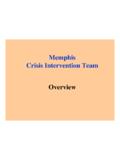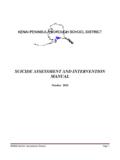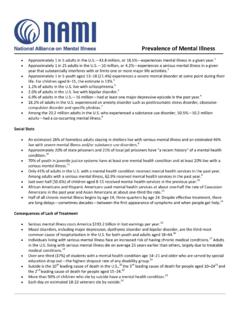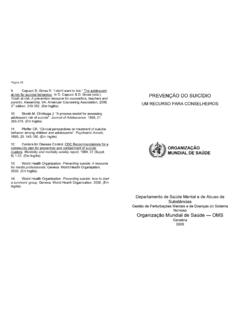Transcription of Edwin S. Shneidman on Suicide
1 suicidology Online 2010; 1:5-18. ISSN 2078-5488 5 Review Edwin S. Shneidman on Suicide Antoon A. Leenaars Norwegian Institute of Public Health, Division of Mental Health, Department of Suicide Research and Prevention Submitted to SOL: 3rd March 2010; accepted: 5th March 2010; published: 8th March 2010 Abstract: Edwin S. Shneidman (DOB: 1918-05-13; DOD: 2009-05-25) is a father of contemporary suicidology . His work reflected the intensive study of Suicide . His contributions on Suicide are some of the essential studies in the field. The works on Suicide can be divided into five parts: Definitional and Theoretical, Suicide Notes, Administrative and Programmatic, Clinical and Community, and Psychological Autopsy and Postvention. In this paper, not only are the selected works explicated, but also Dr. Shneidman s writings are shared on each category, to allow reader to understand Suicide and Edwin S.
2 Shneidman better. Copyrights belong to the Author(s). suicidology Online (SOL) is a peer-reviewed open-access journal conforming to the Budapest Open Access Initiative. * ..it requires a strong moral principle to prevent me from deliberately stepping into the street, and methodically knocking people s hats off then it is high time to get to sea as soon as I can. This is my substitute for pistol and ball. Herman Melville, Moby Dick. Edwin S. Shneidman (DOB: 1918-05-13; DOD: 2009-05-15) is a father of contemporary suicidology . He was born on May 13, 1918. His passion in life was to understand Suicide , maybe only equaled by his love of Melville s Moby Dick (1853). Moby Dick, itself, is an extraordinary study in Suicide . It is true that happenstance marked Shneidman s career. While working at the LA Veterans Administration in 1949, he was asked to write condolence letters to widows of two victims by Suicide .
3 He researched the two cases at the LA County Coroner s Office and there was led to a vault of Suicide notes. He never looked back. Shneidman spent his life studying why people kill themselves, indeed, the intensive and creative study of people who died by Suicide . He saw much of the study of Suicide , what is called suicidology , as half-paralyzed , and suggested that suicidology should be about the comprehensive understanding of the individual. His life s mission was to forestall death as long as possible. To accomplish this mission, he * Antoon A. Leenaars, , C Psych. Norwegian Institute of Public Health, Division of Mental Health, Department of Suicide Research and Prevention Box 4404 Nydalen. 0403 Oslo Norway Tel: 1-519-253-9377 Fax: 1-519-253-8486 Email: created a new discipline, named it, contributed to it, and most importantly, catalyzed other competent investigators to invest in it.
4 He was a pioneer. He loved his work. His scholarly writings in suicidology reflect the efforts, and indeed, allow us to understand the suicidal mind better. Shneidman 's work is central to suicidology . It is voluminous. In order to reduce these to his essential papers on Suicide , a task was urged on him, and finally received his approval on January 2, 1996. The idea was not new; it came from Shneidman 's own edited volume on the selected works of Henry A. Murray, his mentor, Endeavors in Psychology, published in 1981. Not only was the idea not new, but also the process followed his with Murray, from January 2, 1996 to finalizing an initial list on July 1, 1997 ("Canada Day" as Shneidman called it, during my regular visits to his home around July 1 to 4th to see him). The final list of papers, reproduced in Table 1, was completed in Shneidman 's home with an update over the years keeping in mind that the final list of contents represented a compromise between the press for greater inclusion and the need to restrict the list to the most representative pieces.
5 The selections were divided into five parts: Definitional and Theoretical, Suicide Notes, Administrative and Programmatic, Clinical and Community, and Psychological Autopsy and Postvention. The intent here is to share with the reader some rather personal reflections to allow the reader to understand Suicide better. The complete papers can be found in my edited volume, Lives and deaths: Selections from the works of Edwin S. Shneidman , published by Brunner/Mazel (Taylor & Francis group) in 1999. Almost all quotes, in fact, are from the selected readings in my edited volume (Leenaars, 1999), so a common source can be suicidology Online 2010; 1:5-18. ISSN 2078-5488 6 Table 1. Selections from the works on Suicide of Edwin S. Shneidman . Definitional and Theoretical (1971). Suicide and suicidology : A brief etymological note.
6 Suicide and Life-Threatening Behavior, 1, 260-264. (1985). A formal definition, with explication (pp. 202 213). Definition of Suicide . New York: Wiley. (1998). Suicide in the Encyclopedia Britannica, 1777-1997. Archives of Suicide Research, 4, 189-199. (1973). Suicide (pp. 383-385). Encyclopedia Britannica (Vol. 21). Chicago: William Benton. (1971). Perturbation and lethality as precursors of Suicide in a gifted group. Life-Threatening Behavior, 1, 23-45. (1992). A conspectus for conceptualizing the suicidal scenario (pp. 50-65). In R. Maris et al. (Eds.) Assessment and prediction of Suicide . New York: Guilford Press. (1993). Suicide as psychache. Journal of Nervous and Mental Disease, 181, 147-149. Suicide Notes (1969). Some characteristics of genuine versus simulated Suicide notes (pp. 527-535). In P. J. Stone et al. (Eds.) The general inquirer: A computer approach to content analysis.
7 Cambridge: MIT Press. (with D. N. Ogilvie and P. J. Stone) (1973). Suicide notes reconsidered. Psychiatry, 36, 379-395. (1980). Self-destruction: Suicide notes and tragic lives (pp. 41-76). Voices of death. New York: Harper and Row. (1995). Letters of enforced death versus Suicide notes. Journal of Psychology and Judaism, 19, 153-160. Administrative and Programmatic (1965). The Los Angeles Suicide prevention center: A demonstration of public health feasibilities. American Journal of Public Health, 51, 21-26. (with N. Farberow) (1967). The NIMH center for studies of Suicide prevention. Bulletin of suicidology , 1, 2-7. (1988). Some reflections of a founder. Suicide and Life-Threatening Behavior, 18, 1-12. Clinical and Community (1967). How to prevent Suicide . Public affairs pamphlet No. 406. New York: Public Affairs Pamphlets. (with P. Mandelkorn) (1994). Clues to Suicide reconsidered.
8 Suicide and Life-Threatening Behavior, 24, 395-397. (1980). Psychotherapy with suicidal patients (pp. 305-313). In T. B. Karasu & L. Bellak (Eds.) Specialized techniques in individual psychotherapy. New York: Brunner/Mazel. (1984). Aphorisms of Suicide and some implications for psychotherapy. American Journal of Psychotherapy, 38, 319-328. (1992). Letter to editor, Rational Suicide and psychiatric disorders. New England Journal of Medicine, 326(13), 889. Psychological Autopsy and Postvention (1977). The psychological autopsy (pp. 42-57). In L. I. Gottschalk et al. (Eds.) Guide to the investigation and reporting of drug abuse deaths. Washington, DC: USDHEW, Government Printing Office. (1994). Comment: The psychological autopsy. American Psychologist, 39(1), 75-76. (1993). An example of an equivocal death clarified in a court of law (pp.)
9 211-246). Suicide as psychache. Northvale: Jason Aronson Inc. (1975). Postvention: The care of the bereaved (pp. 245-256). In R. O. Pasnau (Ed.) Consultation in liaison psychiatry. New York: Grune and Stratton. suicidology Online 2010; 1:5-18. ISSN 2078-5488 7 found. However, the rights are from the original text, and belong to Edwin Shneidman . David Shneidman , his son, granted permission to quote from the selections (David Shneidman , personal communications, March 2, 2010). Suicide In his reflections, Edwin Shneidman does not know whether Suicide was looking for him or he was looking for Suicide . However, on a day in 1949, when he discovered 100 s of genuine Suicide notes , he was restless and looking for some niche in psychology. Here is verbatim what Shneidman (1991) wrote: The fulcrum moment of my suicidological life was not when I came across several hundred Suicide notes in a coroner s vault while on an errand for the director of the VA hospital, but rather a few minutes later, in the instant when I had a glimmering that their vast potential value could be immeasurably increased if I did not read them, but rather compared them, in a controlled blind experiment, with simulated Suicide notes that might be elicited from matched nonsuicidal persons.
10 My old conceptual friend, John Stuart Mill s Method of Difference, came to my side and handed me my career. (Leenaars, 1999, p. 247). In religion, we talk about Epiphanies and Epiphany moments. That the notes were genuine was an epiphanic moment for Shneidman . He had an autonomic reaction with the feeling, without verbalizing, that it was important to say genuine Suicide note. Within a couple of months of saying genuine and then simulated and then eliciting notes, and then calling Norman Farberow, he was beginning a career and a discipline. He said, oh boy, Suicide notes, the golden road to Suicide , and suicidology began. Disregarding all of biology and genetics, Professor Shneidman stated that Suicide is essentially psychological pain. It is not entirely so, and maybe not centrally so, but that is what, he stated, we can investigate and explicate.





